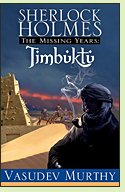Timbuktu
by Vasudev Murthy
Reviewed by Margaret Tomlinson

Timbuktu imaginatively portrays what might have happened during the "missing years" between Sherlock Holmes's supposed death at Reichenbach Falls in 1891 and his return to London in 1894. Holmes is, of course, a completely fictional character invented by Arthur Conan Doyle, who attempted to kill Holmes off in his short story "The Final Problem." Fans refused to accept the detective's death, and Doyle revived him in "The Empty House."
Timbuktu follows Murthy's novel Sherlock Holmes, the Missing Years: Japan. That means it's neither a sequel or a prequel but an alternative to the Japan tale, and a fascinating alternative it is, with Watson and Holmes traveling through the deserts and oases of northern Africa in the company of a tribe of Tuaregs. Holmes, with his penchant for writing monographs on obscure subjects, is in his element, with Watson figuratively rolling his eyes whenever Holmes expresses his intention to write about Tuareg music, Arabic calligraphy, the salt mines of Taghaza, etc., etc. From time to time the opinionated Watson addresses the reader on literary subjects, particularly his disdain for readers who insist on "an endless stream of stories celebrating blood and depravity." Blood and depravity there is, but the chief delight of this novel, as in Holmes stories old and new, is the unflappable perspicacity of its hero and his deep interest in the virtues, flaws and peculiarities of men and women, whether from his own or another culture.
The plot revolves around an ancient manuscript, torn in two by the great medieval world traveler Ibn Batuta, an concealed in two different locations to prevent the unworthy from learning its secret. Holmes, in possession of one half, travels in hot pursuit of the other, with the evil Professor Moriarty hot on his trail. A supernatural twist at the end is not consistent with the classic Holmes canon, but even purists should have plenty of fun getting there. (2016, 304 pages) More about Timbuktu at Powell's Books or Amazon.comOther Sherlock Holmes pastiches:
Sherlock Holmes, the Missing Years: Japan by Vasudev Murthy (2015). More info
The Fifth Heart by Dan Simmons (2015), Holmes teams up with Henry James to investigate the suicide of Clover Adams, wife of a historian related to two U.S. Presidents. More info
The House of Silk by Anthony Horowitz (2011), about a case involving an art dealer in fear of his life. See review or more info at Powell's Books
Nonfiction about the Tuaregs and Ibn Batuta:
The Tuareg or Kel Tamasheq: The People Who Speak Tamasheq and a History of the Sahara by Henrietta Butler (2016). More info
The Tuareg: People of Ahaggar by Jeremy Keenan (2003). More info
The Travels of Ibn Batuta in the Near East, Asia and Africa by Ibn Batuta (14th century), translated by Samuel Lee (1829). More info
Online:
The Tuareg of the Sahara
Who Was Ibn Batuta?
Back to Nineteenth-Century Europe
Back to Directory of Book Reviews